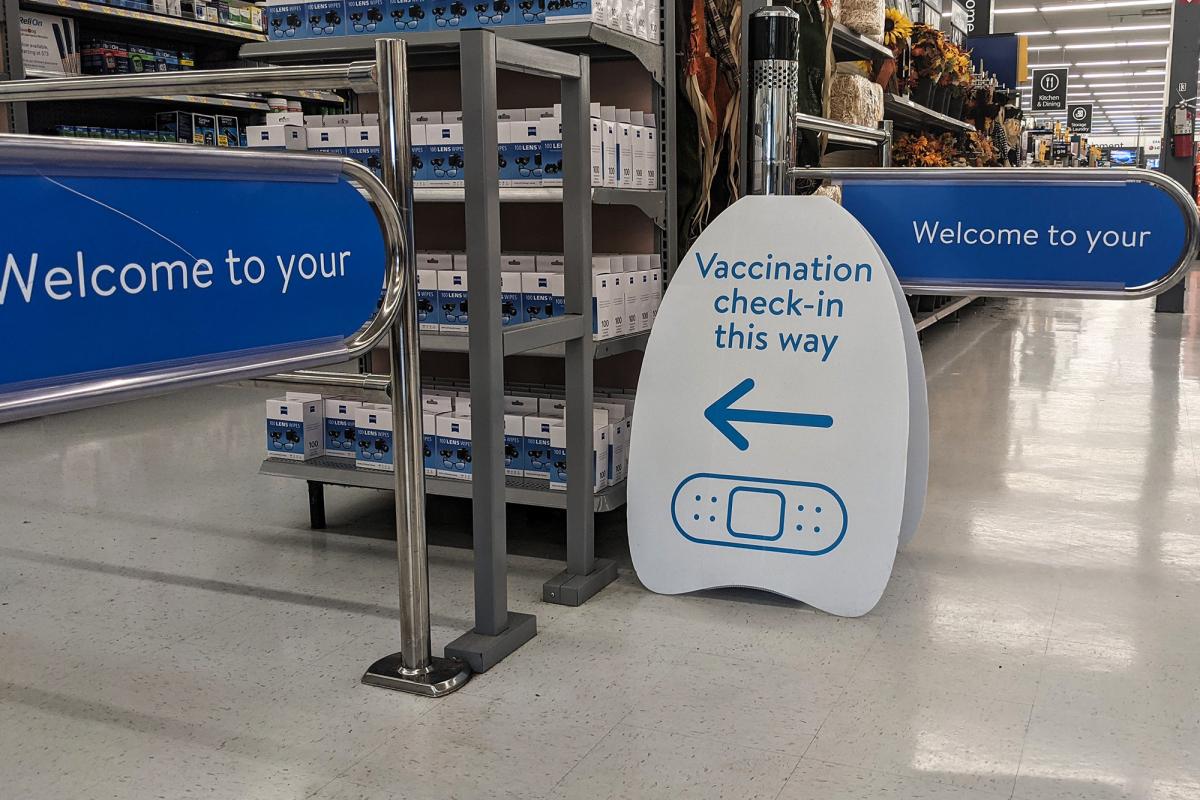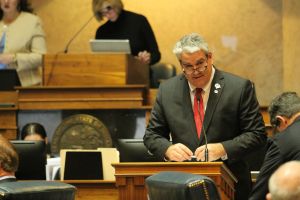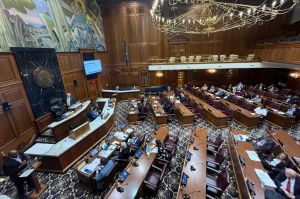
While the total count of breakthrough cases have more than tripled since the beginning of August, the data suggests vaccines are still limiting severe illness and deaths. (Lauren Chapman/IPB News)
Gov. Eric Holcomb signs a new COVID-19 executive order after conferring with hospitals. New student COVID-19 cases break another pandemic record. And Indiana surpasses 14,000 confirmed deaths.
THE DATA
After reporting several days with more than 100 Hoosier deaths in December, Indiana’s daily deaths plummeted. May averaged 9.7 deaths per day, June averaged 6.4, July averaged 4.5 deaths – but with incomplete data in August, Indiana has averaged more than 15 deaths per day.
It’s important to note: deaths take longer to report than cases, so this number is likely to rise.
The state surpassed its most recent grim milestone of 14,000 confirmed COVID-19 deaths on Monday.
Indiana averaged 4,280 new cases per day the last week of August. As recently as June, daily cases reached a pandemic-low average – just 282 cases per day. July’s daily average climbed to more than 600 per day.
The Indiana Department of Health added more than 5,000 new breakthrough COVID-19 cases to its dashboard Thursday.
While the total count of breakthrough cases have more than tripled since the beginning of August, the data suggests vaccines are still limiting severe illness and deaths.
IDOH added 5,259 new breakthrough cases, 75 new hospitalizations and 22 new deaths to its dashboard Thursday.
But the data doesn’t suggest that vaccines aren’t working. The best vaccine efficacy was at 95 percent. And the promise of vaccines is the prevention of serious illness or death.
Compared to the total population, confirmed COVID-19 cases are 60 percent less likely to result in death and 72 percent less likely to result in hospitalization if the person is fully vaccinated.
COVID-19 IN SCHOOLS
Indiana School COVID-19 Cases Set New Record As State Pushes For More Testing
The state's latest update on COVID-19 in schools shows 5,529 newly reported student cases – a new record for the second week in a row.
More than 4,000 of the newly reported student cases are from Aug. 21-27. Many schools have updated mask policies as outbreaks continue, and some have been forced to go fully virtual due to massive numbers of kids required to quarantine.
Now, state officials are pushing for more COVID-19 reporting and testing in schools, but one of the state's largest school districts says finding enough people and time to increase testing efforts remains difficult.
READ MORE: How Is Indiana Distributing COVID-19 Vaccines? Here's What You Need To Know
Indiana Eases COVID-19 Quarantine Rules For Schools That Mask Up
The Indiana Department of Health is loosening its school COVID-19 quarantine policy – but only for schools that are masking up.
The new school guidance said close contacts do not have to quarantine at all, as long as everyone in the classroom is wearing a mask throughout the school day.
That new guidance only applies to the classroom, not to close contacts in non-classroom or extracurricular settings.
Otherwise, outside the classroom or in those where masks aren’t being worn, the previous guidance still applies – as much as 14 days quarantine, or as little as seven days, with a negative test.
Indiana’s Youth COVID-19 Vaccination Remains Low As Delta Variant Sweeps Through Schools
Kids are finally back to in-person school, but the COVID-19 pandemic continues to disrupt learning. Cases are on the rise due to the highly contagious delta variant, which has also increased the number of youth hospitalizations.
Despite the surge, the vaccination rate for eligible children remains low. And a new study shows that it may not increase.
Approximately 4 in 10 parents will only vaccinate their children if required, according to the new survey from IUPUI. Researchers surveyed more than 10,000 Indiana caregivers, with respondents from nearly every county in the state.
It paints a grim picture of the future of the pandemic: the delta variant spreading across the country and landing more children in emergency rooms, all while the efficacy of vaccines appears to be waning.
“Are we going to see more breakthrough infections because of this? That's my biggest fear,” said Thomas Duszynski, an epidemiologist from IUPUI. “That's why I look at the data and say we are not going to get through this until we can vaccinate and protect that younger population.”
However, evidence is clear that the COVID-19 vaccines still offer significant protection against hospitalization and death. As the pandemic rages on, it’s evident that children are at risk.
THE STATE’S RESPONSE
On Aug. 30, Gov. Eric Holcomb extended an executive order related to health care workers for just two days. Throughout the pandemic, Holcomb has extended orders similar to this one for an entire month. The governor’s office said at the time that it was to gather input from hospital systems on how best to help them during the current surge of COVID-19 cases.
Holcomb didn’t shed any additional light on that decision when questioned by reporters, nor why those conversations with hospital systems weren’t finalized before Holcomb’s previous executive order expired.
Holcomb Imposes New COVID-19 Requirement On Hospitals, Avoids ‘Draconian’ Measures
On Sept. 1, he signed an executive order, which runs through September, that mandates hospitals report to the state when they’re diverting patients to other facilities. That will help Indiana officials better manage resources statewide.
The executive order also asks insurers to extend prior authorizations for non-emergency procedures being postponed because of the COVID-19 surge. And it makes it easier for advanced practice nurses to provide care across multiple locations around the state.
The new order also reimposes two requirements for government benefits that had been suspended during the pandemic. One requires welfare recipients to look for work to keep their benefits. The other forces unemployment recipients to wait a week before the state will pay them their benefits.
HEADLINES
CDC Eviction Moratorium Had Limited Effectiveness, Especially In Indiana
The Centers for Disease Control and Prevention eviction moratorium, which the U.S. Supreme Court ended last month, was somewhat effective in keeping people in their homes. But the state’s moratorium, in place last year during the first few months of the pandemic, was far more effective.
The state eviction moratorium put in place by Gov. Eric Holcomb from mid-March to mid-August last year led to fewer than 200 eviction filings per week statewide. That’s 87 percent less than pre-pandemic averages.
But the CDC moratorium only led to a 28 percent decline from the average number of weekly evictions before the pandemic.
Resources Are Available For Renters Facing Eviction. Should Courts Be Obligated To Notify Them?
With the end of the Centers for Disease Control and Prevention’s eviction moratorium, thousands of eviction cases can now start moving through state courts.
An estimated 90,000 Hoosiers are behind on their rent – and there are millions of dollars in federal rental assistance waiting to help them. Most of them don’t know it’s available. One place renter advocates say that problem could be fixed is in the eviction courts.
Judges could notify tenants of what is available to them – but are not required to.
At a court in Lawrence Township in Marion County, attorneys have been offering legal services to renters facing eviction filings.
In one room, Brandon Beeler, housing law center director for Indiana Legal Services, walked 19-year-old renter Dylan Snipes through her filing.
“They say you are behind in rent. It looks like they are claiming you stopped paying on June 1 – is that correct?” Beeler asked.
Snipes explained that after a job fell through, she was unable to make rent.
Then, Beeler asked if Snipes had applied for rental assistance. Snipes said she hadn’t, and explained that she looked at the application for rental assistance but found it confusing.
You Asked About Eviction And Housing Issues. We've Got Answers
After the U.S. Supreme Court recently blocked the Centers for Disease Control and Prevention's eviction moratorium, there’s a brighter spotlight than ever on evictions, which are increasing in number even as they continued throughout most of the pandemic.
IPB News has received a lot of questions about evictions and housing issues, so we reached out to housing advocates at Prosperity Indiana to get some answers.
Most Jobs Are Slowly Recovering In Indiana, But Not In Finance Sector
Most industries in Indiana have continued to see job recovery in 2021. But, despite a brief recovery, the finance industry has shed thousands of workers since March 2021.
According to Bureau of Labor Statistics data, now the number of Hoosiers in banking is trending back down and it’s almost back to it’s 2020 low.
Roger Lee, a board member for the Indianapolis chapter of the Chartered Financial Analyst Society, said it’s likely a combination of factors. A federally-imposed low interest rate means banks are making less money. Meanwhile, brick and mortar banks are closing as the pandemic saw more people banking online.
Contact Lauren at lchapman@wfyi.org or follow her on Twitter at @laurenechapman_.











